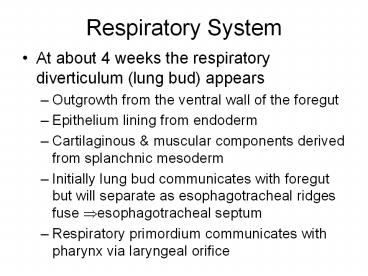Respiratory System PowerPoint PPT Presentation
1 / 15
Title: Respiratory System
1
Respiratory System
- At about 4 weeks the respiratory diverticulum
(lung bud) appears - Outgrowth from the ventral wall of the foregut
- Epithelium lining from endoderm
- Cartilaginous muscular components derived from
splanchnic mesoderm - Initially lung bud communicates with foregut but
will separate as esophagotracheal ridges fuse
?esophagotracheal septum - Respiratory primordium communicates with pharynx
via laryngeal orifice
2
Larynx
- Internal lining from endodermal origin
- Cartilages muscles originate from mesenchyme of
4th 6th pharyngeal arches - All muscles innervated by braches of vagus (X)
- As cartilages form, the laryngeal epithelium
proliferates rapidly temporarily occluding lumen - Subsequently vacuolization recanalization
occur-a pair of lateral recesses form ?laryngeal
ventricles - Bounded by folds of tissue that differentiate
into false true vocal cords
3
Branches of X CN
- Superior laryngeal nerve
- Innervates derivatives of the 4th pharyngeal arch
- Recurrent laryngeal nerve
- Innervates derivatives of the 6th pharyngeal arch
4
Trachea, Bronchi, Lungs
- During its separation from foregut the lung bud
forms the trachea two lateral outpocketings
(bronchial buds) - At beginning of the 5th week each bud enlarges ?
forming right left main bronchi - Right ? forms 3 secondary bronchi
- Will give rise to 3 lobes
- Left ? forms 2 secondary bronchi
- Will give rise to 2 lobes
5
Trachea, Bronchi, Lungs (cont.)
- With subsequent growth in both caudal lateral
directions the lung buds penetrate into the
coelomic cavity - Space is narrow ? pericardioperitoneal canal
- Gradually filled by expanding lung buds
- Ultimately the pericardioperitoneal canals are
seperated from the peritoneal pericardial
cavities by the pleuroperitoneal
pleuropericardial folds
6
Pleural cavity (space)
- Mesoderm which covers the outside of the lung
develops into the visceral pleura - Somatic mesoderm layer, covering the body wall
from the inside becomes the parietal pleura - The space between the above is the pleural
cavity/space - After birth a negative pleural pressure (vacuum)
keeps the lungs inflated against the chest wall
7
Secondary bronchi
- During further development secondary bronchi
divide repeatedly in dichotomous fashion forming - 10 tertiary (segmental) bronchi in right lung
- 8 tertiary (segmental) bronchi in left lung
- Creation of the bronchopulmonary segments of the
adult lung - By the end of the 6th month approximately 17
generations of subdivisions have formed - Additional 6 divisions will form postnatally
8
Maturation of the lungs
- Up to the 7th month the bronchioles divide
continuously into more smaller canals
vascular supply ? steadily - Respiration becomes possible when some cuboidal
respiratory bronchiole cells ? - Into thin flat cells which are associated with
numerous blood lymph capillaries - Surrounded spaces ? terminal sacs or primitive
alveoli - During 7th month sufficient capillaries are
present lung is mature enough allowing the
premature infant to survive
9
Maturation of lungs (cont.)
- In the last two months of prenatal life for
several years postnatally the of terminal sacs
(alveoli) ? - Alveolar epithelial cells lining the sacs
- Type I (majority)
- Become thinner allowing capillaries to protrude
into sacs ? respiratory membrane - Type II (minority)
- Develops at end of 6th month
- Produces surfactant
- phospholipid which ? surface tension
10
Maturation of lungs (cont.)
- Before birth the lungs are filled with fluid
- High Chloride concentration
- Little protein
- Some mucus from bronchial glands
- Surfactant from type II alveolar epithelial cells
- Amount ? especially during last 2 weeks before
birth - Fetal breathing movements begin before birth
cause aspiration of amniotic fluid - Movements are important
- lung development
- Condition respiratory muscles
11
Respiration at birth
- When respiration begins at birth
- Most of lung fluid rapidly resorbed by
- Blood
- Lymph capillaries
- Small amount expelled via bronchi trachea
during delivery - After fluid is resorbed surfactant remains
deposited as a thin phospholipid coat on the
alveolar cell membranes - preventing a water-air interface during breathing
thus keeping surface tension minimized - Without surfactant alveoli would collapse during
expiration (atelectasis)
12
Alveoli
- Estimated that only 1/6 of adult number of
alveoli are present at birth - Remaining alveoli are formed during first 10
years postnatally through the continuous
formation of new primitive alveoli - Growth of lungs after birth is 1o due to an ? in
the of respiratory bronchioles alveoli, not
an ? in size of the alveoli
13
Congenital defects
- Tracheoesophageal fistula
- Can be associated with polyhydramnios
- Amniotic fluid may not pass to stomach
intestines - Gastric contents and/or amniotic fluid may enter
trachea through a fistula - Causing pneumonitis and pneumonia
- Congenital cysts
- Formed by dilation of terminal or larger bronchi
- May be small multiple giving the lung a
honeycombed appearance on X-ray - May be restricted to one or more larger ones
- Drain poorly frequently cause chronic infections
14
Congenital defects (cont.)
- Absence of lungs
- Rare, not compatible with life
- Agenesis of one lung
- Rare, compatible with life
- Abnormal divisions of the bronchial tree
- More common
- Supernumerary lobules
- Little functional significance, but may cause
unexpected difficulties in bronchoscopy - Ectopic lung lobes
- May arise from trachea or esophagus from
additional respiratory buds
15
Respiratory Distress Syndrome a.k.a hyaline
membrane disease
- Lack of surfactant in premature infant
- Risk that the alveoli will collapse during
expiration causing respiratory distress synd. - Common cause of death in premature infants
- 20 of all infant deaths in newborn period
- Partially collapsed alveoli contain fluid with
high protein content, many hyaline membranes,
lamellar bodies probably from surfactant layer - Treatment with artificial surfactant
glucocorticoids to surfactant production have
significantly ? mortality

